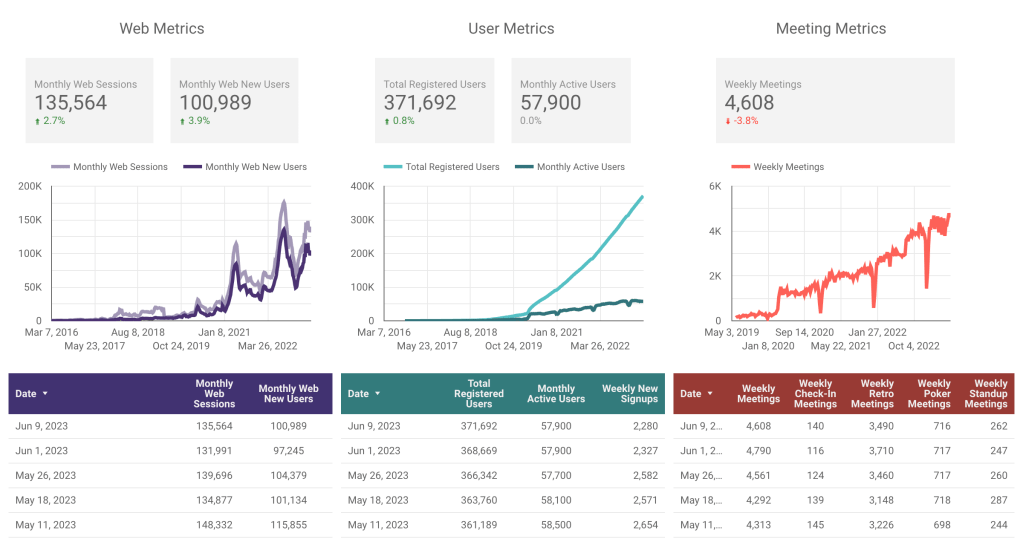#351 – Setting Strategy, v9.0
Friday Ship #351 | June 9th, 2023

This week, we held a virtual retreat on the leadership team and refreshed our strategy.
Since I joined Parabol more than 3 years ago, this is the 9th iteration of our strategy, a short brief that tells our teams where we’re headed and when we wanna get there. We now refresh our strategy every 4 months, taking a pause from the day-to-day to reflect on what we’ve learned since our last update, and adjust our course.
And because evolving how we work is core to our DNA as a company, each time we do it, we do something slightly different. This edition could truly be called the 9th version that I’ve seen of our strategy setting process, and v9.0 has included some meaningful improvements.
Everyone Writes a Draft
At first, the leadership team was pretty small – mostly just myself and our CEO & co-founder, Jordan. We started adding more voices to the leadership team about 2 years ago, with the latest addition being Marcus, Head of Product Development, about a year ago, around v7.0 of strategy setting.
At that time, the process was still strongly hinging on Jordan. He would write the first draft, and we’d respond and edit. But with more members, a larger company, and a broader overall scope, there also came more divergent perspectives among our team about what we should focus on.
So there came our first change: every member of the leadership team wrote their own version of the strategy brief.
That meant we were no longer anchored by Jordan’s perspective, and could offer more different ideas about what to do.
But with every feature comes a bug: combining those perspectives into one cohesive strategy was a slog. We spent a week in confusing and long Slack threads, and at the end, we had a strategy, but no one was happy.
Problems Before Solutions
For v8.0, we realized that by just sharing our own ideas, we were diverging too late in the process. Instead, we needed to first see the the company from each others’ perspectives, and align on the problems before proposing solutions. We also wanted to make sure we were looking at all the areas of Parabol – not just users, but also revenue and business; not just customers, but also team members and culture.
And since we’re a company that has a meeting tool and values doing as much as possible async, we built our process on Parabol:
- [Async] Open a retro board for all leadership team members to reflect on challenges & opportunities for users, team & culture, investors & business.
- [Sync] Group reflections into themes, vote and discuss. Write problem statements or give names to each of the groups we’ve identified.
- [Async] Open a sprint poker meeting and rate the problem statements. The prioritization framework (what we’re rating on) is defined by Jordan, and could change each cycle. Jordan then resolved the rating into a prioritized list.
- [Sync] Propose solutions for the prioritized list of problems in the form of Goal statements, following our existing strategy brief format.
With this version, we fixed our bug – it was much easier to synthesize the final draft solutions into one strategy brief for the company.
But of course we also introduced another bug: now the process took 4 weeks instead of 1. To make matters worse, because the cycle happened over the December holidays, we had a 2-week break in the middle.
Going Sync to Save Time
Finally, we arrived at v9.0, and this time, we needed to solve for time: how could we go through a similarly rich and thoughtful process, but without sitting in limbo for up to 6 weeks?
We made two critical changes:
- We changed the timing of our strategy refresh process so it didn’t coincide with the holidays or end of the year 🤦♀️
- We held a virtual retreat.
Over the course of three 2.5-hour sessions on subsequent days, we got together on a call to complete steps 2-4 of the process. We did most of the same async stuff, except we resolved prioritization differences through discussion (vs Jordan making the call on his own), we spent more time talking through nuances of topics along the way, and we eventually split up the goals so the person leading each one would write the detailed prose and define the timeline.
This process feels like our best one yet, but as with each iteration, I’m sure there’s a bug in this version, and I can’t wait to find it and improve.
Metrics

Our metrics this week are mostly green. MAU is flat and weekly meetings are down, but on par with usual fluctuations.
This week we…
…added 50 🤯 new templates across lessons learned, pre-mortem and post-mortem meetings. This means there’s a lot more that teams can now do with Parabol!
…ran our monthly user feedback retro. We combined ~30 pieces of user feedback into themes, and added it to issues on our backlog so we can better prioritize.
…started our consent-based process to form a DevOps team. While most of our Product team works in mission-based squads, our DevOps team members who support all of that work have been squad-less as their efforts aren’t specifically tied to any of the current missions. We hope this new team will give our team members a sense of home.
Next week we’ll
…propose our shiny new strategy to the rest of the company!
